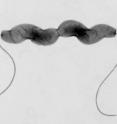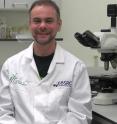The need to feed programs Campylobacter's 'Sat Nav'
A rumbling tummy is our body's way of telling us "it's time for lunch." Likewise, bacteria need to know when it's time to eat. Researchers at the Institute of Food Research on the Norwich Research Park have uncovered how the food-borne bacterial pathogen Campylobacter jejuni can change its swimming behaviour to find a location with more food.
Campylobacter is the most common cause of bacterial food-borne illness in the UK, with more than 371,000 cases annually. When people get infected, the bacteria need to find their way from the source of contamination, most often undercooked poultry, to the cells lining the gut, passing through thick layers of mucus. In these different locations, Campylobacter must find enough food to sustain itself as well as a suitable environment to carry out respiration, the process of generating energy.
Using a newly developed assay, the researchers found that Campylobacter balances the directions given by two different systems to either seek out more nutritious locations, or to find places where respiration is most efficient. Genetic tools were used to show that the system controlling swimming towards food overrides the other system, suggesting that the "need to feed" is the foremost concern for Campylobacter.
Unlike other food poisoning bugs, such as E. coli or Salmonella, Campylobacter has a whole range of systems that can detect different chemicals in the environment, and alter swimming behaviour accordingly: the 'Sat Nav' of the bacterial world.
The work is published in the journal PLOS ONE. Dr Mark Reuter, the lead author says "we know that Campylobacter can swim, and that this is very important for causing disease, but aimless swimming isn't efficient. The bugs need to know where they want to go."
Discovering how these 'Sat Nav' systems help target the bugs to the site of infection may help prevent future disease, and may be relevant to other food-borne and gut-associated pathogens.
The Institute of Food Research, which is strategically funded by the Biotechnology and Biological Sciences Research Council, has a research team dedicated to studying Campylobacter. They are looking at what makes Campylobacter such a successful pathogen and to find weaknesses in its biology that could lead to new ways of controlling it.
Source: Norwich BioScience Institutes
Other sources
- The need to feed programs Campylobacter's 'Sat Nav'from Science DailyWed, 30 Jan 2013, 3:00:47 UTC
- The need to feed programs Campylobacter's 'Sat Nav'from PhysorgTue, 29 Jan 2013, 22:00:28 UTC

